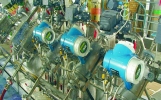

Endress+Hauser, a leading supplier of measuring instruments and automation solutions for the industrial process engineering industry, has an extensive range of products and services suitable for use in the pulp and paper industry. Endress+Hauser has been active in the automation market for decades and has extended this expertise to the pulp and paper industry.
Pulp and paper making is an extensive procedure consisting of numerous processes and applications. From wood handling to pulp making to utilities and effluent treatment, the processes involved need to be monitored and controlled in a range of applications from level, pressure, flow measurement to temperature and liquid analysis.
The first step in pulp and paper making involves wood handling. Logs delivered to the plant are screened, debarked, and then fed into a chipping machine. This is mainly a mechanical process and the major instrumentation element needed is for level measurement where ultrasonic, radar sensing techniques and radiometric Gamma programmes are used. These methods are especially useful in a process where contact free measurement is preferable. Radiometric level measurement products are ideal for application in the wood chipping process, as they can cope with the limited space and harsh environment, and can measure from outside through the wall of the storage vessel.
The actual pulp making process, either chemical, mechanical, or waste paper pulping, requires specifically designed instrumentation to cope with the harsh environment. Chemical pulping is the most demanding process incorporating high temperatures, presence of vacuum, corrosive and abrasive substances, and vibrations. The ideal solution for this would be one that requires little to no maintenance.
Different types of paper are determined by different basis weights, that is, grams per square metre. The making of container grade, fine paper, newsprint and tissue all require the use of measuring parameters, like level, flow, pressure and analysis, in order to produce high quality products. The typical measurement applications include headbox, level and pressure, direct mass flow measurement for chemical additives, on-line viscosity measurement, stock preparation flow applications, abrasive pressure applications, and automated pH measurement on white water.
There are various utilities in the pulp and paper mill that need to be controlled. One of the most important, present in the chemical pulping process, is the recovery of spent cooking chemicals. This lengthy process starts off with the feeding of weak black liquor, or waste, into the evaporators. It is converted into thick black liquor or fuel for the recovery boiler. In the recovery boiler system, the thick black liquor is burnt, producing steam and electrical energy which is used in the mill, and green liquor which is sent to the causticising area. In the re-causticising process, the raw green liquor from the recovery boiler is converted to cooking liquor through various chemical and physical processing operations where lime from the lime kiln and green liquor is mixed. The final step is calcinations, where kilns convert the lime mud generated by causticising reaction to lime. The use of level measurement of lime with guided radar is good in this application, as the radar is not affected by the angle of material. Electro magnetic flowmeters are useful in the measurement of green liquor as the devices are sensitive and stable.
Other utilities include power generation, such as bark boilers or multifuel boilers, and chemical preparation. The instrumentation measurements used in these utilities vary from corrosive pressure applications, density measurement and radar level measurement to conductivity, vortex technology and energy management.
Apart from the actual paper making process, the effects of this production on the environment is a critical issue. The pulp and paper industry has worked over the years to establish a consistent, scientifically defensible approach for monitoring the effects. Sample collections for physical, chemical and toxicological analyses include effluent, sediment, receiving water and tissues. Critical measurement parameters in the secondary effluent treatment are thermal mass flow, pH, dissolved oxygen and turbidity. The typical applications for addressing these issues include fully automated pH measurement system, reliable DO and turbidity measurement and in-situ UV sensor for nitrate.
While the core of Endress+Hauser's focus is the development of instruments that acquire, transmit and use process information, the company also provides valuable expertise that is evident in the total, integrated solutions and services on offer. Endress+Hauser can manufacture instruments according to specific requirements and offers instrument maintenance training, measurement technology training, system solutions, e-services, a 24 hour emergency help desk, field service, and specialised engineering, installation, and commissioning.
For more information contact Grant Joyce, Endress+Hauser, 011 262 8000, [email protected], www.za.endress.com
| Tel: | +27 11 262 8000 |
| Email: | [email protected] |
| www: | www.endress.com |
| Articles: | More information and articles about Endress+Hauser South Africa |

© Technews Publishing (Pty) Ltd | All Rights Reserved